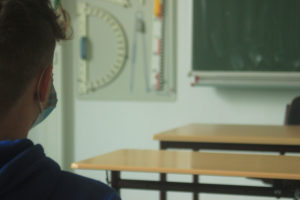Class Not Dismissed: COVID-19 and the Imbalance of US Education
 Photo by Maximilian Scheffler on Unsplash
Photo by Maximilian Scheffler on Unsplash For many Americans, August means back to school—and while many school children traditionally bemoan the return to studying, homework, and the like, this year public health specialists are dreading it too, as the United States continues to combat rising coronavirus cases.
Because the virus spreads easily in close proximities, the ongoing peril of exposure makes reopening schools (in the traditional sense) very challenging. However, instead of dealing with the complexities of the challenge, over the last few months Education Secretary Betsy DeVos has mainly feuded with concerned families, teachers, and education advocates and remained steadfast about reopening schools for the new academic year.
Earlier in the summer, DeVos spoke on her imperative to reopen schools, baselessly claiming that children don’t get or transmit COVID-19. Despite her claim, almost 100,000 kids tested positive for the virus in the last two weeks of July. And of the five million people with the virus in the country, about 370,000 of them are children.
A photo that recently circulated of a packed hallway on the first day of school at North Paulding High School in Georgia makes those numbers especially scary. Few students are wearing masks in the photo, and according to one student’s tally, a minority of her classmates were wearing masks. Considering that Georgia has almost 200,000 cases and has experienced a significant jump in new daily cases since June, this reopening attempt was not bound to end well. Sure enough, there were nine detected cases of COVID-19 at North Paulding, and who knows how many other cases in asymptomatic carriers.
Meanwhile Georgia Governor Brian Kemp remains adamantly against a mask mandate in schools. In late July, 260 school staffers in Georgia’s largest school district were exposed to or contracted COVID-19. Despite CDC guidance advising against testing K-12 students and staff, it’s lucky that the staffers were tested and could refrain from further school matters before exposing colleagues or their students.
As various government employees, officials, and agencies around the country eschew common sense, taking classes online feels like a sensible choice to protect students and faculty from the virus. While some US school systems decided to go virtual, not all of them have the luxury—and it’s more often monied public school systems and private schools that do remote learning, leaving many K-12 students in the dust.
In many regards, the coronavirus has accentuated areas of wealth and resource disparity to an extreme degree. Most of the debate between educators and DeVos involved the safety to open up public schools. Private schools are held as an exception to those discussions—many of which have a religious affiliation and considerably more resources (millions, in fact) to shield students from virus exposure.
Supreme Court cases from over the summer granted religious institutions more latitude to exercise their religious freedom, while still funneling taxpayer dollars to parochial schools. In Espinoza v. Montana Department of Revenue, the court ruled that Montana’s no-aid clause to religious institutions was discriminatory and that state scholarship funds could subsidize private school tuition.
While the ongoing favoritism toward religious institutions is concerning—especially when it comes to education—we must remember it’s nothing new for Betsy DeVos. Her goal as education secretary is to fundamentally undermine the credibility of American public schools and bolster parochial schools. COVID-19 has given her an extra vulnerability to exploit.
What concerns me the most about the public health threat to schools is the realization that access to education is not universal, and those with resources can almost always adapt and leave behind those who are lacking resources. We have a very real educational gap in the United States, not caused by the virus but exposed by it.
Private schools can generally spend about twice as much per student as public schools can. Their wherewithal extends beyond adapting classrooms for health and safety, and to the size of classrooms themselves, preparedness of educators, and any distance learning resources (like computers for students) in case classes need to go remote or a student shows symptoms of COVID-19. Many of these additional adjustments are because private schools are ultimately accountable to the students’ parents—if the parents are displeased with a school, they can withdraw their students and the school loses money. Public schools cannot compete because of the resource disparity, but most students attending public schools do not have the luxury to choose schools.
In situations where families are displeased with private schools, many can afford private teachers to educate their children in “learning pods” independent of school systems—public or private. As has been continuously iterated at this point, the easiest way to avoid the virus is to stay at home, and with a one-on-one teacher, or a small bubble of peers in a living room in the suburbs (as these pods can offer) there’s considerably less of a risk than in packed public-school classrooms.
Sadly, the uncertainty of the pandemic creates a disparity where the wealthy can advance and those without considerable resources remain stifled. COVID-19 further exposes the need to provide more resources to our public education system—to enable more children with quality, accessible education. Students shouldn’t have their education impeded because their families cannot afford a private school or private tutor.
